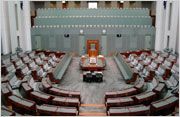Archived News for Green Sector Professionals
A new way to accurately measure nitrous oxide emitted during agricultural production has been developed by Queensland University of Technology (QUT) researchers.
Professor Richard Conant, a Smart Futures Fellow at QUT's Institute for Future Environments, said the new statistical approach would greatly improve estimates of global nitrous oxide (N2O) emissions by up to 65 per cent.
"Nitrous oxide contributes substantially to total global greenhouse gas emissions and in some countries it's a big part of total emissions," he said.
CEC slams ‘unexpected’ tariff cut
The Clean Energy Council (CEC) has slammed the Federal Government’s decision to cut its solar hot water program, saying that the move will directly jeopardize thousands of jobs.
Victoria to get new panel to assess wildlife control applications
The Victorian Government has established a new panel to assess applications to control wildlife across the state that are of significant community interest.
Snowy River's fish declared an endangered ecological community
The aquatic ecological community in the catchment of the Snowy River in NSW has been listed as an Endangered Ecological Community by the Fisheries Scientific Committee (FSC).
Cost of regulations and subsidies reduce effectiveness of carbon pricing
Subsidies and regulations could seriously reduce the effectiveness of Australia’s forthcoming carbon price scheme, according to a piece in the latest Australian Economic Review.
Study urges action on climate change
A lack of scientific knowledge is no longer the problem in countering the effects of climate change, but rather it is a lack of action.
AGIC launches infrastructure sustainability rating
The Australian Green Infrastructure Council has launched the nation’s first national scheme for rating infrastructure sustainability. The rating system has been developed co-operatively with many of the AGIC’s membership organisations.
WA releases new protection plan for parks
The Western Australian Government has released a reformed management plan for the Shannon and D’Entrecasteaux national parks.
Victoria takes alpine grazing to Federal Court
The struggle between the Victorian and Commonwealth governments over alpine grazing is continuing after the Victorian Government has requested the Federal Court to review the recent decision by the Commonwealth Environment Minister Tony Burke to stop a research trial into the use of strategic cattle grazing as a bushfire risk mitigation and fuel reduction tool in Victoria's high country.
Bill to ban mining in Arkaroola passes SA Upper House
The South Australian Government has passed legislation that will ban mining in the state’s Arkaroola Wilderness Sanctuary after the bill was successfully passed by the Upper House.
Tas EPA launches air quality notification system
The Tasmanian Environmental Protection Authority (EPA) has launched an early warning smoke detection system to be dlievered online.
Clean Energy Jobs and Competitiveness program regulations released
The Minister for Climate Change and Energy Efficiency, Greg Combet, has announced that regulations to establish the Jobs and Competitiveness Program under the Clean Energy Act 2011 are now in place.
Targeted water purchase initiative starts
The Federal Government has begun a new strategic water purchase initiative in the southern connected system of the Murray-Darling Basin.
Sustainability Victoria review results released
The Victorian Government has released the findings from the review into Sustainability Victoria (SV), which State Minister for Environment and Climate Change Ryan Smith says will help chart a course for a more effective investment in waste reduction and improved energy measures.
Green collar income growth stalls
A recent survey has found that the exponential growth of environmental professionals has plateaued.
ABIR grant program opens
The Federal Government has opened the new $15 million Advanced Biofuels Investment Readiness (ABIR) Program for applications. The announcement comes after the awarding of a $5 million grant to James Cook University to develop a macro-algae biofuel project.
International call for Coral Sea no-take reserve
More than 300 eminent scientists from 21 other countries around the world have urged the Australian Federal Government to create the world’s largest no-take marine reserve in the Coral Sea.
International expedition to monitor coral health on Great Barrier Reef
A pioneering scientific expedition that will document the health of coral on the Great Barrier Reef will be undertaken as a joint venture between global technology giant Google, the UQ Global Change Institute, not-for-profit organisation Underwater Earth, and insurance company Catlin.
The Catlin Seaview Survey aims to carry out the first comprehensive study of the composition and health of Reef coral to a depth of 100m.
The project's chief scientist, Professor Ove Hoegh Guldberg from the Global Change Institute at The University of Queensland said the scientific data gathered would strengthen the understanding about how climate change and other environmental changes are likely to affect ocean ecosystems like the Great Barrier Reef.
“The visual nature of the project will also help bridge the gap between scientific knowledge and public awareness,” Professor Hoegh-Guldberg said.
“The Catlin Seaview Survey comprises a series of studies which will reveal to the public one of the last frontiers on Earth: the oceans.
“For the first time in history, we have the technology to broadcast the findings and expedition through Google. Millions of people will be able to experience the life, the science and the magic that exists under the surface of our oceans. This project is very exciting.”
Professor Hoegh-Guldberg said the survey was not just another scientific expedition; it aimed to capture the public's imagination and engage people with the science like never before.
The Catlin Seaview Survey camera, developed specifically for the expedition, will capture thousands of 360-degree underwater panoramas. When stitched together, these will allow people to choose a location, dip underwater and go for a virtual dive at all of the locations visited by the expedition.
Google is collaborating with the Catlin Seaview Survey and is working on a new feature on Panoramio (which links photos to locations), so that the 360-degree panorama images can be uploaded and made available to millions of people worldwide.
This will eventually mean that roughly 50,000 panoramas from the Survey will be accessible on Catlin Seaview Survey in partnership with Google Earth and Google Maps.
The project also will have a dedicated YouTube channel and the ability to broadcast Hangouts on air, which allows people to watch livestreams of the expedition team from the ocean floor.
The Catlin Seaview Survey will include a shallow reef survey, a deep reef survey and a megafauna survey, which combined will provide a baseline assessment of the composition, biodiversity and wellbeing of the Reef. The expedition will launch on the Great Barrier Reef in September 2012.
The Catlin Seaview Survey will comprise three surveys:
1. The Shallow Reef Survey will use a custom-designed underwater vehicle with a 360-degree camera to generate imagery of the reef. In collaboration with The University of Queensland, this will be assessed using image recognition software to enable a rapid visual census of corals, fish and many other organisms at 20 sites across the entire length of the 2300km Great Barrier Reef. This will provide a broad-scale baseline for understanding climate change on coral reefs.
2. The Deep-Water Survey will use diving robots to explore the reef at depths of 30-100 metres. Little is known of this region, yet it may hold some of the secrets of whether or not the coral reefs will survive rapid climate change. Using a combination of high-definition cameras, deep-diving robots and survey equipment, the deep-water component will provide a comprehensive study of the health, composition and biodiversity of the deep-water reefs.
3. The Mega-Fauna Survey team, led by Emmy award-winning cinematographer and shark researcher Richard Fitzpatrick, will study the migratory behaviour of tiger sharks, green turtles and manta rays in response to increasing seawater temperatures. A total of 50 animals will be tracked with satellite tags that continuously monitor their geographic position, temperature and depth. This data can then be compared against oceanographic data to get a better understanding of the animals' behaviour and migrational responses to the warming of the oceans.
The Catlin Seaview Survey is sponsored by Catlin Group Limited, an international insurance and reinsurance company. Stephen Catlin, the founder and chief executive of Catlin Group Limited, said:
“We are sponsoring the Catlin Seaview Survey so that experts obtain objective scientific data they require to make more reliable conclusions about the impact of climate and environmental changes on our oceans and our planet as a whole. The results will be broadcast on a scale never attempted before, so it is an exciting time for science. We're proud to be part of the team leading this pioneering project.”
“As an insurer, Catlin offers our clients protection against many types of risks, so it is natural that we should lead the way in sponsoring research to discover the risks of tomorrow.”
The Catlin Seaview Survey is collaboration between global insurance company Catlin Group Limited, not-for-profit organisation Underwater Earth (project creators) and partner Google.
The content captured through the Catlin Seaview Survey will be added to Google platforms and will also be available on the Catlin Seaview Survey website - www.catlinseaviewsurvey.com.
Study shows health imacts of rural air pollution
Poor air quality in Wagga Wagga contributes to ill health, according to a study led by Charles Sturt University (CSU) health researcher, Mr Tony Kolbe.
Greens push for Murray inquiry
The Federal Greens have announced their intentions to push for the establishment of a Senate inquiry into the Murray Darling Basin Authority’s draft plan.
Australia’s ten most endangered landscapes named
A team of leading ecologists from the Innovative Research Universities (IRUs) has released a list of the continent’s ten most highly-threatened environments.
The researchers warn that these environments are all at risk of reaching ‘tipping points’ where they may change rapidly and irreversibly into alien landscapes, often dominated by introduced or unfamiliar species.
“Nine of the ten most vulnerable ecosystems in Australia occur here in Queensland. The IRU team has identified and prioritised the key threats to these ecosystems. Unless all parties in the upcoming State election make a commitment to addressing these threats, Queensland faces an irreversible and catastrophic loss to our biodiversity,” says Griffith researcher and School of Environment Head, Professor Hamish McCallum.
“If these ecosystems reach "tipping points", there will be major consequences for our tourism industry, primary industries, and the well-being of the entire Queensland community.
“This needs to be a major issue in the forthcoming election.”
The IRU has published “Protecting Australia’s most endangered landscapes”, ranking landscapes according to the extent of their vulnerability and the scale of threats to them.







